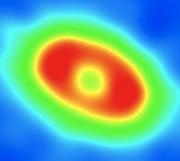Circumstellar Disks and Planet Formation
At least 1 in 10 nearby Sun-like stars hosts a giant planet. A massive effort is underway to find more exoplanets, determine their key properties, and associate demographic trends with models of their formation. Ultimately, the goal is to develop a robust theoretical framework grounded in this growing suite of empirical evidence that explains how different kinds of planets are made. That formation process is intimately tied to the initial conditions in the reservoirs of planet-building material - the disks around young stars. Our work focuses on interpreting high angular resolution observations of the gas and dust in disks at radio wavelengths, to learn about the physical (densities, temperatures), material (grain sizes, turbulence), and chemical properties of these planetary nurseries.
Sean Andrews, Til Birnstiel, Michael Dunham, Lars Kristensen, Charles Lada, Karin Oberg, Chunhua (Charlie) Qi, David Wilner.
Ongoing Collaborator: Anaelle Maury




